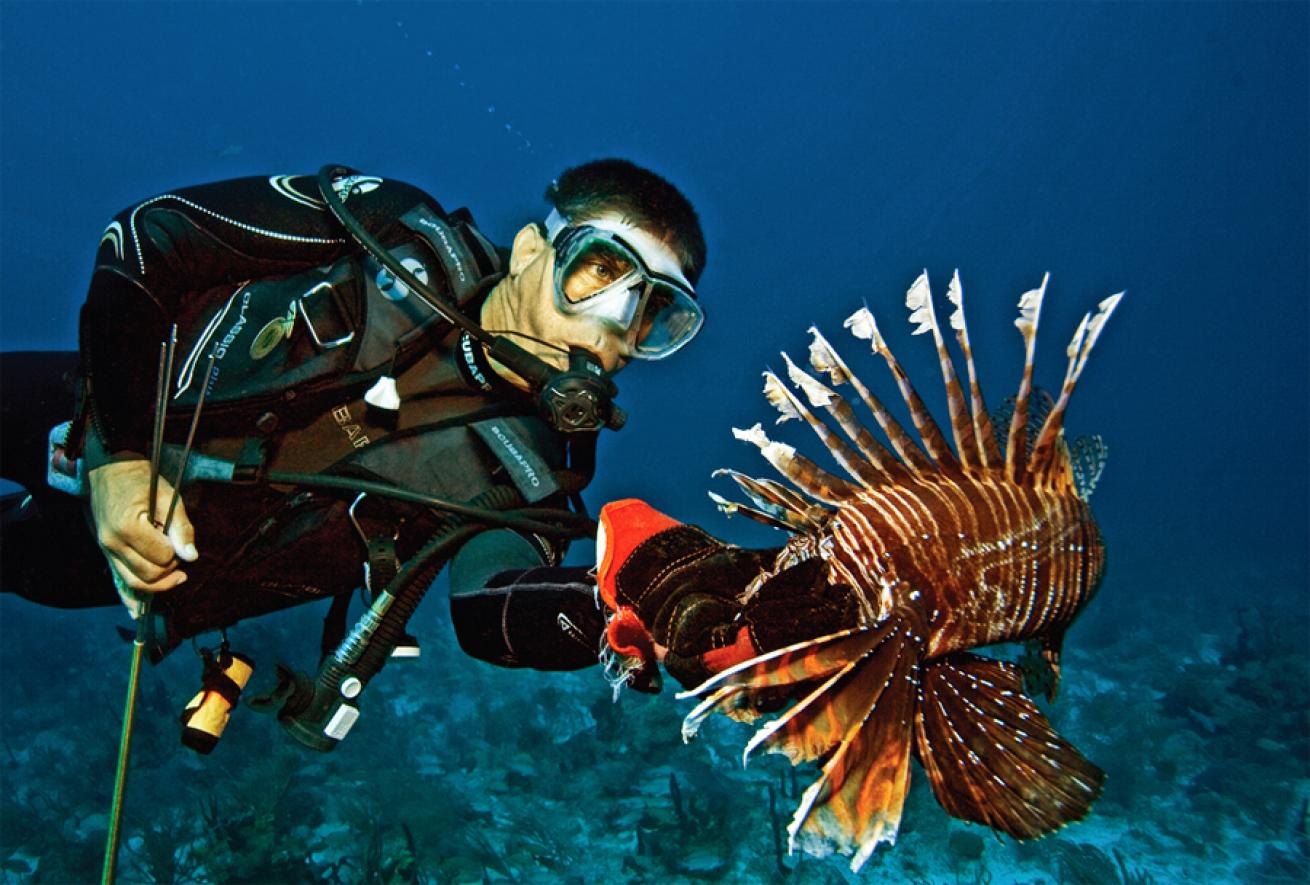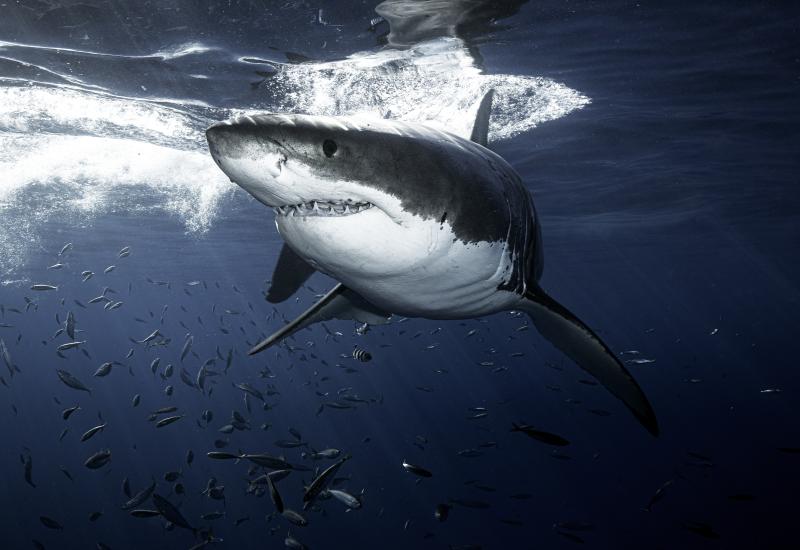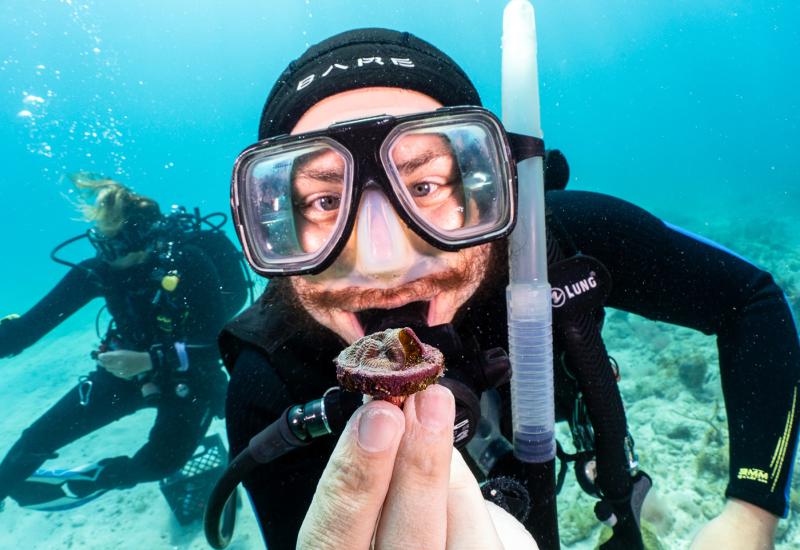Lad Akins Spearheads the Battle Against Invasive Lionfish Species

August 2014 Scuba Diving Sea Hero: Lad Akins
Courtesy Lad Akins
Lad Akins has spearheaded the battle against invasive lionfish in the Atlantic for nearly a decade via his leadership at Reef Environmental Education Foundation REEF. For his tireless efforts, Lad Akins is our August Sea Hero.
How did you first get involved with REEF? And with the lionfish problem?
Getting started with REEF was a matter of being in the right place at the right time with the right skills and attitude. I was working for Spencer and Amy Slate as an instructor in 1990, when Paul Humann and Ned DeLoach came down to Key Largo to try out this crazy idea of identifying and recording all of the fish we could find on a dive. I was pretty skeptical … until I got about 10 minutes into that first dive. It was big fun! And the after-dive discussions were great too. Seeing big, burly Spencer, who is famous for his barracuda and moray interactions, get excited about finding a little redlip blenny was priceless. I was hooked. I went on to work with Ned and Paul as REEF’s first executive director and have been very fortunate in the opportunities that have been presented as a result: saturating for eight days as an aquanaut in the Aquarius habitat, solo-piloting Deepworker submersibles on a project with Dr. Sylvia Earle, serving as a U.S. delegate to South Africa to work on marine protected areas, discovering new species of fish and being named a NOAA Environmental Hero. I’ve also gotten to dive with Ned DeLoach, which is a highlight in itself! The rest, as they say, is history (still being made!).
As for lionfish, that really started in about 2006. REEF’s longest-running program has been the fish-survey project (the one that we started in 1990), and through that program we would occasionally get reports of fish that didn’t belong where they were sighted. I believe the first of these were the four Indo-Pacific batfish at Molasses Reef in 1994. Since they were in our own backyard, we were able to proactively remove these fish (which went on exhibit as educational displays at the New England and Florida Aquariums) and prevent further establishment. But we weren’t so lucky with the lionfish. What started as a few sightings off Southeast Florida exploded into the first successful invasion of a marine fish anywhere in the Atlantic. Dr. James Morris at NOAA called us up in about 2005 to talk about how we may be able to help, and we’ve been working throughout the region to address the invasion ever since.
What has been the biggest challenge you and REEF have faced regarding the lionfish invasion?
There have been a number of hurdles that we have all had to deal with regarding this invasion. First, it wasn’t on anyone’s radar, and nothing like this had ever happened before. That meant governments and marine-resource managers didn’t even have legal language in place to address an invasive marine fish. The pace of the invasion has been frightening as well. Even though many people have been working hard to address the issue, it’s been challenging trying to keep up. The spatial extent is also quite daunting when you consider lionfish are found from inches deep along shorelines to depths of more than 1,000 feet (verified via submarine observation) and year-round from North Carolina to South America including the Gulf of Mexico. That’s a huge area, much of it beyond diving depths. We are working hard at developing tools and technologies to reach those inaccessible areas.
What's been your most rewarding moment?
While the invasion has been very frustrating to deal with, REEF is an optimistic organization, and we don’t give up easily. It has been very rewarding to see recreational divers take a lead role in addressing this invasion. REEF has been conducting, collecting and handling workshops and trainer workshops around the region for a number of years; and the fruits of diver removal efforts are being realized in the form of successful local control. Working with great partners in the scientific and government communities — Dr. James Morris, Dr. Stephanie Green, Dr. Pam Schofield and others — has been very rewarding and productive. It’s not often that an issue allows such broad collaborations between non-profits, governments, universities, businesses and the public. Helping author the “best practices” manual for invasive lionfish and the regional and U.S. national control strategies has been gratifying. Mostly, though, it’s great to see the dive industry being the fins in the water on this issue.
How can everyday divers and Scuba Diving's readers help further REEF's work?
I am glad you asked! I’d like to start out by saying diving is the greatest recreation in the world, but all of the training and equipment only get you into the water — it’s what you do there that really matters. More and more opportunities are presenting themselves for divers to become involved — everything from helping to transplant nursery-raised corals to conducting fish surveys to taking part in lionfish removals. The key for divers is to use the very special opportunities they’re afforded to go beyond simply looking around and to join in activities that help make a difference. And active divers — divers with a purpose — stay in the sport. They get more comfortable and have way more fun than those divers just swimming around without a purpose.
As far as REEF programs go, learning the fish and other marine life you are diving with is a first step, like learning the names of the people you are standing next to at a party. How boring would it be to stand alone in a crowd without knowing a thing about anyone there? Learning about fish is like making new friends — you know who’s who and what they all do. Conducting surveys is also great fun, like a treasure hunt underwater, and the data are extremely useful for better understanding and managing our marine resources.
Joining in on lionfish removal events or taking part in REEF’s weeklong survey programs affords additional learning and conservation opportunities. For lionfish, even non-divers can help by ordering it on the menu. Every lionfish eaten is one more out of the water and one fewer grouper or snapper taken. Of course funding is also a necessary part of allowing all of this work to happen and I’m (still) learning how to be better at asking for support. We stretch dollars a long way at REEF, and it is great to see how many people believe in what we do and provide support to continue our great work.
What's next for Lad Atkins and REEF?
REEF has a number of exciting programs and projects that it is working on, including increased educational opportunities through both in-person and online activities. We are expanding REEF headquarters with the recent purchase of property adjacent to our headquarters in Key Largo. The fish-survey program continues to expand [globally] and the data are being used more and more by scientists, educators and resource managers. We continue to expand our lionfish research and control programs, and we are looking forward to developing new tools and techniques to broaden the scope of effective removals. I currently sit on a number of state, regional and international committees and working groups; I’ll continue to serve these groups and REEF wherever I am needed most, but I certainly look forward to continuing to bridge the gap between science, management and recreation.
Is there anything we did not ask that you would like readers to know about? Tell us what's on your mind!
Divers Rock! Really. All of my best friendships have been formed through diving and the work we do at REEF. More than 60,000 members of REEF have supported this work, and the real thanks should go to them — and to the incredible Founders and Board of Trustees at REEF as well. People don’t realize that they give considerable time and energy to the organization without compensation and often little recognition. What Paul Humann and Ned DeLoach started with REEF has been incredible to watch, and what board members like Peter Hughes, Marty Snyderman, Andy Dehart and others give of their incredibly precious time is humbling. And REEF staff, interns and volunteers are simply the best. It’s a great organization! REEF.org
More Oris Sea Heroes:
Gwyn Mills | Troy Bodden | Jessica Cramp | Sea Hero Nominations
Learn more about Sea Heroes & Oris Watches, and view all past recipients of the award (www.scubadiving.com/content-hub/scuba-diving-sea-heroes-oris-watches)

Courtesy Lad AkinsAugust 2014 Scuba Diving Sea Hero: Lad Akins
Lad Akins has spearheaded the battle against invasive lionfish in the Atlantic for nearly a decade via his leadership at Reef Environmental Education Foundation REEF. For his tireless efforts, Lad Akins is our August Sea Hero.
How did you first get involved with REEF? And with the lionfish problem?
Getting started with REEF was a matter of being in the right place at the right time with the right skills and attitude. I was working for Spencer and Amy Slate as an instructor in 1990, when Paul Humann and Ned DeLoach came down to Key Largo to try out this crazy idea of identifying and recording all of the fish we could find on a dive. I was pretty skeptical … until I got about 10 minutes into that first dive. It was big fun! And the after-dive discussions were great too. Seeing big, burly Spencer, who is famous for his barracuda and moray interactions, get excited about finding a little redlip blenny was priceless. I was hooked. I went on to work with Ned and Paul as REEF’s first executive director and have been very fortunate in the opportunities that have been presented as a result: saturating for eight days as an aquanaut in the Aquarius habitat, solo-piloting Deepworker submersibles on a project with Dr. Sylvia Earle, serving as a U.S. delegate to South Africa to work on marine protected areas, discovering new species of fish and being named a NOAA Environmental Hero. I’ve also gotten to dive with Ned DeLoach, which is a highlight in itself! The rest, as they say, is history (still being made!).
As for lionfish, that really started in about 2006. REEF’s longest-running program has been the fish-survey project (the one that we started in 1990), and through that program we would occasionally get reports of fish that didn’t belong where they were sighted. I believe the first of these were the four Indo-Pacific batfish at Molasses Reef in 1994. Since they were in our own backyard, we were able to proactively remove these fish (which went on exhibit as educational displays at the New England and Florida Aquariums) and prevent further establishment. But we weren’t so lucky with the lionfish. What started as a few sightings off Southeast Florida exploded into the first successful invasion of a marine fish anywhere in the Atlantic. Dr. James Morris at NOAA called us up in about 2005 to talk about how we may be able to help, and we’ve been working throughout the region to address the invasion ever since.
What has been the biggest challenge you and REEF have faced regarding the lionfish invasion?
There have been a number of hurdles that we have all had to deal with regarding this invasion. First, it wasn’t on anyone’s radar, and nothing like this had ever happened before. That meant governments and marine-resource managers didn’t even have legal language in place to address an invasive marine fish. The pace of the invasion has been frightening as well. Even though many people have been working hard to address the issue, it’s been challenging trying to keep up. The spatial extent is also quite daunting when you consider lionfish are found from inches deep along shorelines to depths of more than 1,000 feet (verified via submarine observation) and year-round from North Carolina to South America including the Gulf of Mexico. That’s a huge area, much of it beyond diving depths. We are working hard at developing tools and technologies to reach those inaccessible areas.
What's been your most rewarding moment?
While the invasion has been very frustrating to deal with, REEF is an optimistic organization, and we don’t give up easily. It has been very rewarding to see recreational divers take a lead role in addressing this invasion. REEF has been conducting, collecting and handling workshops and trainer workshops around the region for a number of years; and the fruits of diver removal efforts are being realized in the form of successful local control. Working with great partners in the scientific and government communities — Dr. James Morris, Dr. Stephanie Green, Dr. Pam Schofield and others — has been very rewarding and productive. It’s not often that an issue allows such broad collaborations between non-profits, governments, universities, businesses and the public. Helping author the “best practices” manual for invasive lionfish and the regional and U.S. national control strategies has been gratifying. Mostly, though, it’s great to see the dive industry being the fins in the water on this issue.
How can everyday divers and Scuba Diving's readers help further REEF's work?
I am glad you asked! I’d like to start out by saying diving is the greatest recreation in the world, but all of the training and equipment only get you into the water — it’s what you do there that really matters. More and more opportunities are presenting themselves for divers to become involved — everything from helping to transplant nursery-raised corals to conducting fish surveys to taking part in lionfish removals. The key for divers is to use the very special opportunities they’re afforded to go beyond simply looking around and to join in activities that help make a difference. And active divers — divers with a purpose — stay in the sport. They get more comfortable and have way more fun than those divers just swimming around without a purpose.
As far as REEF programs go, learning the fish and other marine life you are diving with is a first step, like learning the names of the people you are standing next to at a party. How boring would it be to stand alone in a crowd without knowing a thing about anyone there? Learning about fish is like making new friends — you know who’s who and what they all do. Conducting surveys is also great fun, like a treasure hunt underwater, and the data are extremely useful for better understanding and managing our marine resources.
Joining in on lionfish removal events or taking part in REEF’s weeklong survey programs affords additional learning and conservation opportunities. For lionfish, even non-divers can help by ordering it on the menu. Every lionfish eaten is one more out of the water and one fewer grouper or snapper taken. Of course funding is also a necessary part of allowing all of this work to happen and I’m (still) learning how to be better at asking for support. We stretch dollars a long way at REEF, and it is great to see how many people believe in what we do and provide support to continue our great work.
What's next for Lad Atkins and REEF?
REEF has a number of exciting programs and projects that it is working on, including increased educational opportunities through both in-person and online activities. We are expanding REEF headquarters with the recent purchase of property adjacent to our headquarters in Key Largo. The fish-survey program continues to expand [globally] and the data are being used more and more by scientists, educators and resource managers. We continue to expand our lionfish research and control programs, and we are looking forward to developing new tools and techniques to broaden the scope of effective removals. I currently sit on a number of state, regional and international committees and working groups; I’ll continue to serve these groups and REEF wherever I am needed most, but I certainly look forward to continuing to bridge the gap between science, management and recreation.
Is there anything we did not ask that you would like readers to know about? Tell us what's on your mind!
Divers Rock! Really. All of my best friendships have been formed through diving and the work we do at REEF. More than 60,000 members of REEF have supported this work, and the real thanks should go to them — and to the incredible Founders and Board of Trustees at REEF as well. People don’t realize that they give considerable time and energy to the organization without compensation and often little recognition. What Paul Humann and Ned DeLoach started with REEF has been incredible to watch, and what board members like Peter Hughes, Marty Snyderman, Andy Dehart and others give of their incredibly precious time is humbling. And REEF staff, interns and volunteers are simply the best. It’s a great organization! REEF.org
More Sea Heroes:
Gwyn Mills | Troy Bodden | Jessica Cramp | Sea Hero Nominations
Learn more about Sea Heroes and view all past recipients of the award (www./seaheroes)










